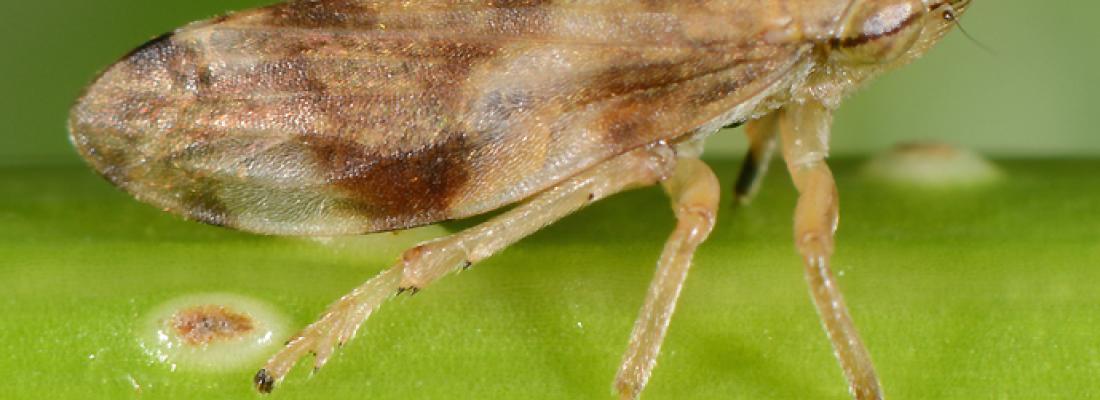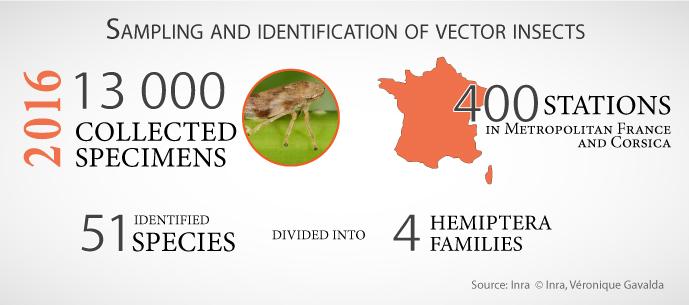Biodiversity Reading time 6 min
Xylella fastidiosa: new research avenues
Published on 26 June 2019

Burned, stunted, dried and scorched leaves. From grapevines in California to Mediterranean ornamental plants and olive trees in Italy, over 350 plant species around the globe, including forest species, are vulnerable to Xylella fastidiosa.
Since 2015, when Xylella was first detected in Corsica and the PACA region (Provence-Alpes-Côte d'Azur), INRA began a race against time, at the request of the French Ministry of Agriculture. The objective was to design and develop state of the art molecular biology techniques to detect the presence of this plant killer, which is transmitted by vector insects.
Mission accomplished! In just two years, knowledge on Xylella has greatly advanced. It is now possible to detect and identify its presence, however small, on a great variety of host plants1. Jean-Pierre Rossi, deputy director of the INRA Plant Health and Environment Division, explains that the different tools designed by INRA researchers are already working and have been sent to the French authorities in charge of health crisis management, in order to ensure proper monitoring of the epidemic. Researchers also began to trace the evolution of Xylella in France and the rest of Europe. The large genetic diversity shown by this pathogen illustrates its capacity to evolve and to adapt to its host. They discovered that the bacterium was perhaps present in France before its first detection in 2015. In fact, the dating analyses on the differences between the American and the French strains revealed that the strains found in France separated from their American cousins 30 to 50 years ago. Through model-based analyses based on the spatial distribution data of the Xylella outbreaks in Corsica, researchers were able to confirm these dates. Beyond the detection of the bacteria, INRA is engaged in the prevention and management of the disease, with emphasis on two complementary approaches: insect vectors and modelling.
The sentinel insect strategy
Why not use vector insects to monitor the development of the disease? The meadow froghopper (Philaenus spumarius), present in most of Europe, is an effective vector of the bacteria and has a wide variety of hosts, from grasses to trees. In the INRA labs, using new high-throughput molecular biology methods, a single specimen provides researchers with two pieces of information: the DNA of the insect and that of the bacterium it hosts, and its subspecies or strain. Soon, they will also be able to obtain the DNA of the plants the insect eats. These studies are a research milestone! Jean-Pierre Rossi explains with enthusiasm that they will not only be able to identify the DNA of the bacteria, but they will also establish the relation between insects and plants, in order to better understand their diet. How is that useful? It will allow them to reconstruct trophic networks and to design prophylactic measures for the future.
Being able to detect the bacteria within an insect population helps to identify risk areas. For example, in Corsica, 20% of the insects captured in 2016 were contaminated, 30% in the case of rockrose scrub. Through the identification of reservoirs, like rockroses, researchers can find ways to assess management strategies, such as, for example, the destruction of certain plants near susceptible crops. From this standpoint, the trophic network approach is extremely important.
From the field to the digital world: complementary preventive tools
The mass of data—epidemiological, landscape structure, plant distribution, etc.—gathered in the field is processed using mathematical models that allow researchers to evaluate the potential impact of different management scenarios through digital simulation. Statistical models that link the places where the bacterium was detected to climate data have already been created and allow the shaping of the potential distribution area of Xylella. Researchers have worked with two subspecies present in Europe, constructing maps based on the data gathered by state agencies in Corsica and the PACA region. They combined all the information with scientific literature on other regions in the world in order to build more complete models. Other models are used to create dynamic risk maps that identify the places where the disease could have a strong agronomic impact. The combination of all these results is useful to organize monitoring measures and to consider prophylaxis as part of sustainable management.
An insect barcode library
Since the summer of 2015, researchers at INRA have established a list of potential vectors in France, containing thousands of specimens. “This is extremely important,” explains Jean-Pierre Rossi, “since the insects that can spread the bacteria are not well known in France and the information on American vector insects cannot be transposed because the genera and species are not the same.”
All the biological information of the species is stocked in Arthemis, a database developed by INRA. Arthemis makes it possible to check the barcode sequence of any insect and to compare it to the sequences from the species stocked in the database. This fast and reliable massive vector identification tool is free and accessible to all.

1 Including trees whose tannins are known to disrupt the amplification techniques of the DNA—which is also the case of certain pigments present in the eyes of the insect. The new molecular biology methods have helped to overcome these technological obstacles.
INRA units involved
- At the Angers centre, a team from the Research Institute on Horticulture and Seeds is working on the bacteria’s biology, its genetic diversity, its evolution, and pathogenicity. They design tools to detect and identify the bacteria and describe the range of host plants and isolated strains in France and Italy. They hold the largest collection of Xylella strains, isolated both in America and in France, open to the public.
- The Center for Biology and Management of Populations, in Montpellier, focuses on the identification of vector insects, the plants they eat and the strain of the bacteria they carry. The lab has established a list of potential vectors in France and Europe. They built a mass identification tool and issued a protocol for the improvement and robotization of the extraction protocols. They are also responsible for the development of Arthemis DB@se, a vector barcode library and database open to the public.
- In Avignon, the Biostatistics and Spatial Processes Unit is responsible for aspects concerning modelling for the purposes of prevention and risk management. These models are vital to understand the propagation of the bacteria in relation to climate and landscape, as well as to map risk zones.
Since 2016, the different teams began publishing the results of their research on Xylella fastidiosa; these include 4 publications on mathematical models, 2 on the bacteria and their diversity and one on the sentinel insects.
References :
- Jacques M.-A., Denancé N., Legendre B., Morel E., Briand M., Mississipi S., Durand K., Olivier V., Portier P., Poliakoff F., Crouzillat D. 2016. New variants of coffee-infecting Xylella fastidiosa issued from homologous recombination. Applied and Environmental Microbiology, 82:1556-1568
- Denance N, Legendre B, Briand M, Olivier V, de BoissesonC, Poliakoff F, Jacques M-A. 2017. Several subspecies and sequence types are associated with the emergence of Xylella fastidiosa in natural settings in France. Plant Pathology, 66:1054–1064
- Soubeyrand, S., de Jerphanion, P., Martin, O., Saussac, M., Manceau, C., Hendrikx, P., & Lannou, C. 2018. Inferring pathogen dynamics from temporal count data: the emergence of Xylella fastidiosa in France is probably not recent. New Phytologist, 219:824–836.
- Cruaud, A, Gonzalez, A-A, Godefroid, M, Nidelet, S, Streito, J-C, Thuillier, J-M, Rossi, J-P, Santoni, S, Rasplus, J-Y. 2018. Using insects to detect, monitor and predict the distribution of Xylella fastidiosa: a case study in Corsica. Scientific Reports, 8:15628. bioRxiv doi: https://doi.org/10.1101/241513
- Martinetti, D. and Soubeyrand, S. (2019). Identifying lookouts for epidemio-surveillance: Application to the emergence of Xylella fastidiosa in france. Phytopathology, 109:265–276.
- Godefroid, M, Cruaud, A, Streito, J-C, Rasplus, J-Y., Rossi, J-P. 2019. Xylella fastidiosa: climate suitability of European continent. Scientific Reports, 9 :8844. https://www.nature.com/articles/s41598-019-45365-y.pdf
- Abboud, C., Bonnefon, O., Parent, E., and Soubeyrand, S. 2019. Dating and local- izing an invasion from post-introduction data and a coupled reaction–diffusion–absorption model. Journal of Mathematical Biology, sous presse https://doi.org/10.1007/s00285-019-01376-x
European collaboration
INRA is fully invested in several European research projects that aim to:
- improve knowledge by supporting applied research programs,
- reinforce monitoring to ensure early detection and a fast eradication of potential new outbreaks, and
- strengthen awareness-raising and information measures
Find out more:
- XF-ACTORS: Xylella Fastidiosa Active Containment Through a multidisciplinary-Oriented Research Strategy
- POnTE: Pest Organisms Threatening Europe
- PROMODE: Harmonized protocol for monitoring and detection of Xylella fastidiosa in its host plants and its vectors (Euphresco network)
- CURE-Xf: Capacity Building and Raising Awareness in Europe and in Third Countries to Cope with Xylella fastidiosa
